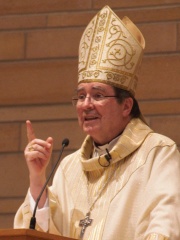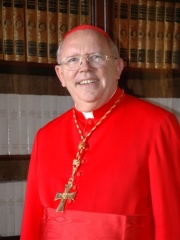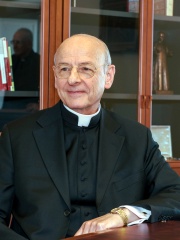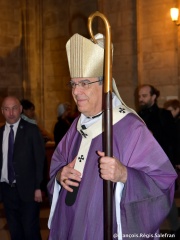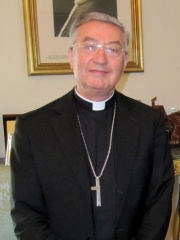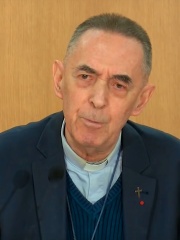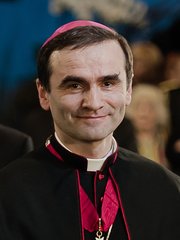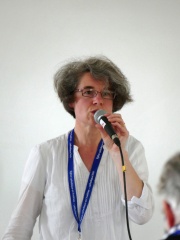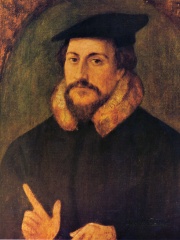



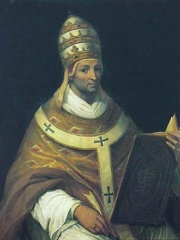



The Most Famous
RELIGIOUS FIGURES from France
This page contains a list of the greatest French Religious Figures. The pantheon dataset contains 3,187 Religious Figures, 226 of which were born in France. This makes France the birth place of the 2nd most number of Religious Figures.
Top 10
The following people are considered by Pantheon to be the top 10 most legendary French Religious Figures of all time. This list of famous French Religious Figures is sorted by HPI (Historical Popularity Index), a metric that aggregates information on a biography's online popularity. Visit the rankings page to view the entire list of French Religious Figures.

1. John Calvin (1509 - 1564)
With an HPI of 85.23, John Calvin is the most famous French Religious Figure. His biography has been translated into 111 different languages on wikipedia.
John Calvin (10 July 1509 – 27 May 1564) was a French theologian, pastor and reformer in Geneva during the Protestant Reformation. He was a principal figure in the development of the system of Christian theology later called Calvinism, including its doctrines of predestination and of God's absolute sovereignty in the salvation of the human soul from death and eternal damnation. Calvinist doctrines were influenced by and elaborated upon Augustinian and other Christian traditions. Various Reformed Church movements, including Continental Reformed, Congregationalism, Presbyterianism, Waldensians, Baptist Reformed, Calvinist Methodism, and Reformed Anglican Churches, which look to Calvin as the chief expositor of their beliefs, have spread throughout the world. Calvin was a tireless polemicist and apologetic writer who generated much controversy. He also exchanged cordial and supportive letters with many reformers, including Philipp Melanchthon and Heinrich Bullinger. In addition to his seminal Institutes of the Christian Religion, Calvin wrote commentaries on most books of the Bible, confessional documents, and various other theological treatises. Calvin was originally trained as a humanist lawyer. He broke from the Roman Catholic Church around 1530. After religious tensions erupted in widespread deadly violence against Protestant Christians in France, Calvin fled to Basel, Switzerland, where in 1536 he published the first edition of the Institutes. In the same year, Calvin was recruited by Frenchman William Farel to join the Reformation in Geneva, where he regularly preached sermons throughout the week. However, the governing council of the city resisted the implementation of their ideas, and both men were expelled. At the invitation of Martin Bucer, Calvin proceeded to Strasbourg, where he became the minister of a church of French refugees. He continued to support the reform movement in Geneva, and in 1541 he was invited back to lead the church of the city. Following his return, Calvin introduced new forms of church government and liturgy, despite opposition from several powerful families in the city who tried to curb his authority. During this period, Michael Servetus, a Spaniard regarded by both Roman Catholics and Protestants as having a heretical view of the Trinity, arrived in Geneva. He was denounced by Calvin and burned at the stake for heresy by the city council. Following an influx of supportive refugees and new elections to the city council, Calvin's opponents were forced out. Calvin spent his final years promoting the Reformation both in Geneva and throughout Europe.

2. Pope Urban II (1042 - 1099)
With an HPI of 82.49, Pope Urban II is the 2nd most famous French Religious Figure. His biography has been translated into 86 different languages.
Pope Urban II (Latin: Urbanus II; c. 1035 – 29 July 1099), otherwise known as Odo of Châtillon or Otho de Lagery, was the head of the Catholic Church and ruler of the Papal States from 12 March 1088 to his death. He is best known for convening the Council of Clermont, which ignited the series of Catholic military expeditions known as the Crusades. Pope Urban was a native of France and a descendant of a noble family from the French commune of Châtillon-sur-Marne. Before his papacy, Urban was the grand prior of Cluny and bishop of Ostia. As pope, he dealt with Antipope Clement III, the infighting of various Christian nations, and the Turkish invasions into Anatolia. In 1095, he started preaching for the start of the First Crusade (1096–1099). He promised forgiveness and pardon for all of the past sins of those who would fight to reclaim the Holy Land from Muslims and free the Eastern churches. This pardon would also apply to those fighting the Muslims in Spain. While the First Crusade resulted in the occupation of Jerusalem and expulsion of the Fatimids, Pope Urban II died before he could receive the news. Urban II also set up the modern-day Roman Curia in the manner of a royal ecclesiastical court to help run the church. He was beatified by Pope Leo XIII on 14 July 1881.

3. Pope Clement V (1264 - 1314)
With an HPI of 82.11, Pope Clement V is the 3rd most famous French Religious Figure. His biography has been translated into 70 different languages.
Pope Clement V (Latin: Clemens V; born Bertrand de Got, died 20 April 1314) was head of the Catholic Church and ruler of the Papal States from 1305 until his death. He is remembered for suppressing the order of the Knights Templar and allowing the execution of many of its members. A Frenchman by birth, Clement moved the Papacy from Rome to Avignon, ushering in the period known as the Avignon Papacy.

4. Pope Urban V (1310 - 1370)
With an HPI of 81.56, Pope Urban V is the 4th most famous French Religious Figure. His biography has been translated into 74 different languages.
Pope Urban V (Latin: Urbanus V; born Guillaume de Grimoard, 1310 – 19 December 1370) was head of the Catholic Church from 28 September 1362 until his death in 1370. He was a member of the Order of Saint Benedict and the only Avignon pope to be beatified. Even after his election as pontiff, he continued to follow the Benedictine Rule, living simply and modestly. His habits did not always gain him supporters who were used to lives of affluence. Urban V pressed for reform throughout his pontificate and also oversaw the restoration and construction of churches and monasteries. One of the goals he set himself upon his election to the Papacy was the reunion of the Eastern and Western Churches. He came as close as some of his predecessors and successors, but did not succeed.
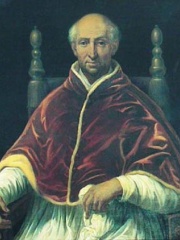
5. Pope Clement VI (1291 - 1352)
With an HPI of 81.53, Pope Clement VI is the 5th most famous French Religious Figure. His biography has been translated into 71 different languages.
Pope Clement VI (Latin: Clemens VI; 1291 – 6 December 1352), born Pierre Roger, was head of the Catholic Church from 7 May 1342 to his death, in December 1352. He was the fourth Avignon pope. Clement reigned during the first visitation of the Black Death (1348–1350), during which he granted remission of sins to all who died of the plague. Roger steadfastly resisted temporal encroachments on the Church's ecclesiastical jurisdiction, and, as pope Clement VI, entrenched French dominance of the Church and opened its coffers to enhance the regal splendour of the Papacy. He recruited composers and music theorists for his court, including figures associated with the then-innovative Ars Nova style of France and the Low Countries.

6. Pope John XXII (1244 - 1334)
With an HPI of 81.45, Pope John XXII is the 6th most famous French Religious Figure. His biography has been translated into 71 different languages.
Pope John XXII (Latin: Ioannes XXII, Italian: Giovanni XXII, French: Jean XXII; 1244 – 4 December 1334), born Jacques Duèze (or d'Euse), was head of the Catholic Church from 7 August 1316 to his death, in December 1334. He was the second and longest-reigning Avignon Pope, elected by the Conclave of Cardinals, which was assembled in Lyon. Like his predecessor, Clement V, Pope John centralized power and income in the Papacy and lived a princely life in Avignon. John opposed the policies of Louis IV the Bavarian as Holy Roman Emperor, which prompted Louis to invade Italy and set up an antipope, Nicholas V. John also opposed the Franciscan understanding of the poverty of Christ and his apostles, promulgating multiple papal bulls to enforce his views. This led William of Ockham to write against unlimited papal power. Following a three-year process, John canonized Thomas Aquinas on 18 July 1323. One of John's sermons on the beatific vision caused controversy which lasted until he retracted his views just before his death. John died in Avignon on 4 December 1334.

7. Pope Innocent VI (1282 - 1362)
With an HPI of 81.33, Pope Innocent VI is the 7th most famous French Religious Figure. His biography has been translated into 70 different languages.
Pope Innocent VI (Latin: Innocentius VI; 1282 – 12 September 1362), born Étienne Aubert, was head of the Catholic Church and ruler of the Papal States from 18 December 1352 to his death, in September 1362. He was the fifth Avignon pope and the only one with the pontifical name of "Innocent". Étienne Aubert, born in the Diocese of Limoges, was a civil law professor and held various positions in the church before being appointed as Cardinal-Bishop of Ostia and Velletri by Pope Clement VI. He became Pope Innocent VI on 30 December 1352. As pope, he revoked an agreement asserting the college of cardinals' superiority over the pope and introduced important reforms in church administration. Through his legate, Cardinal Albornoz, he aimed to restore order in Rome. Innocent VI played a significant role in the 1360 Treaty of Brétigny between France and England. Though he declined an offer to unite the Greek Orthodox Church with the Roman See in exchange for support, his papacy was marked by financial challenges due to wars in Italy and the aftermath of a plague. To address these challenges, he reduced the chapel staff and sold works of art. Innocent VI was a patron of letters and is generally considered just and merciful, although criticized by some, such as St. Bridget of Sweden, for his actions against the Fraticelli. He died on 12 September 1362 and was succeeded by Urban V. His tomb is located in the Chartreuse du Val de Bénédiction in Villeneuve-lès-Avignon.

8. Pope Gregory XI (1370 - 1378)
With an HPI of 80.63, Pope Gregory XI is the 8th most famous French Religious Figure. His biography has been translated into 74 different languages.
Pope Gregory XI (Latin: Gregorius XI; born Pierre Roger de Beaufort; c. 1329 – 27 March 1378) was head of the Catholic Church from 30 December 1370 to his death, in March 1378. He was the seventh and last Avignon pope and the most recent French pope. In 1377, Gregory XI returned the papal court to Rome, ending nearly 70 years of papal residency in Avignon, in modern-day France. His death was swiftly followed by the Western Schism involving two Avignon-based antipopes.

9. Pope Benedict XII (1280 - 1342)
With an HPI of 80.51, Pope Benedict XII is the 9th most famous French Religious Figure. His biography has been translated into 70 different languages.
Pope Benedict XII (Latin: Benedictus XII, Italian: Benedetto XII, French: Benoît XII; 1285 – 25 April 1342), born Jacques Fournier, was a cardinal and inquisitor, and later, head of the Catholic Church from 30 December 1334 to his death, in April 1342. He was the third Avignon pope and reformed monastic orders and opposed nepotism. Unable to remove his capital to Rome or Bologna, Benedict started the great palace at Avignon. He settled the beatific vision controversy of Pope John XXII with the bull Benedictus Deus, which stated that souls may attain the "fullness of the beatific vision" before the Last Judgment. Despite many diplomatic attempts with Emperor Louis IV to resolve their differences, Benedict failed to bring the Holy Roman Empire back under papal dominance. He died 25 April 1342 and was buried in Avignon.

10. Pope Clement IV (1190 - 1268)
With an HPI of 80.43, Pope Clement IV is the 10th most famous French Religious Figure. His biography has been translated into 68 different languages.
Pope Clement IV (Latin: Clemens IV; c. 23 November 1190 – 29 November 1268), born Gui Foucois (Latin: Guido Falcodius; French: Guy de Foulques or Guy Foulques) and also known as Guy le Gros (French for "Guy the Fat"; Italian: Guido il Grosso), was Bishop of Le Puy (1257–1260), Archbishop of Narbonne (1259–1261), Cardinal of Sabina (1261–1265), and head of the Catholic Church from 5 February 1265 until his death. His election as pope occurred at a conclave held at Perugia that lasted four months while cardinals argued over whether to call in Charles I of Anjou, the youngest brother of Louis IX of France, to carry on the papal war against the Hohenstaufens. Pope Clement was a patron of Thomas Aquinas and of Roger Bacon, encouraging Bacon in the writing of his Opus Majus, which included important treatises on optics and the scientific method.
People
Pantheon has 226 people classified as French religious figures born between 101 and 1969. Of these 226, 10 (4.42%) of them are still alive today. The most famous living French religious figures include Christophe Pierre, Jean-Pierre Ricard, and Fernando Ocáriz Braña. The most famous deceased French religious figures include John Calvin, Pope Urban II, and Pope Clement V. As of April 2024, 2 new French religious figures have been added to Pantheon including Jean-Paul Vesco, and Philippe Jourdan.
Living French Religious Figures
Go to all RankingsChristophe Pierre
1946 - Present
HPI: 61.89
Jean-Pierre Ricard
1944 - Present
HPI: 60.56
Fernando Ocáriz Braña
1944 - Present
HPI: 60.03
Raël
1946 - Present
HPI: 59.34
Michel Aupetit
1951 - Present
HPI: 57.40
Jean-Louis Bruguès
1943 - Present
HPI: 57.23
Jean-Paul Vesco
1962 - Present
HPI: 56.70
Claude Dagens
1940 - Present
HPI: 55.42
Philippe Jourdan
1960 - Present
HPI: 52.37
Nathalie Becquart
1969 - Present
HPI: 50.43
Deceased French Religious Figures
Go to all RankingsJohn Calvin
1509 - 1564
HPI: 85.23
Pope Urban II
1042 - 1099
HPI: 82.49
Pope Clement V
1264 - 1314
HPI: 82.11
Pope Urban V
1310 - 1370
HPI: 81.56
Pope Clement VI
1291 - 1352
HPI: 81.53
Pope John XXII
1244 - 1334
HPI: 81.45
Pope Innocent VI
1282 - 1362
HPI: 81.33
Pope Gregory XI
1370 - 1378
HPI: 80.63
Pope Benedict XII
1280 - 1342
HPI: 80.51
Pope Clement IV
1190 - 1268
HPI: 80.43
Bernard of Clairvaux
1090 - 1153
HPI: 80.31
Pope Callixtus II
1065 - 1124
HPI: 79.92
Newly Added French Religious Figures (2025)
Go to all RankingsOverlapping Lives
Which Religious Figures were alive at the same time? This visualization shows the lifespans of the 25 most globally memorable Religious Figures since 1700.

